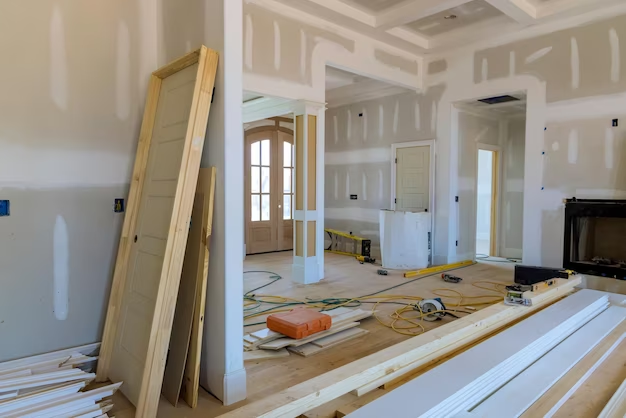 Although looks aren't everything, and the exterior of your home couldn't possibly tell buyers everything they need to know about it in a single glance: they will base a lot of their opinion on it on just those first few seconds. Instead of letting a lackluster exterior stop them from being interested, boost your house's value, and keep the HOA happy by kicking your curb appeal up a notch. These are the top renovations to boost your curb appeal dn give buyers a property they'll want to explore. 1. They Judge a Book By Its CoverOne of the main issues with drive-buy home buyers is that if they dislike any part of the exterior, it'll be harder to win them over on the interior of your property. It's vital that you stop and upgrade your porch and walkways as soon as possible. These are the first points of contact, and no buyer wants to feel like they’re walking into a project. Fix any cracks or lines in walkways and driveways, and deep clean your porch. Giving your front entrance a fresh coat of paint, and some cozy furniture, will change everything! 2. The Chance to Boost Native PlantsA green lawn can be beautiful, but it's not the easiest or most affordable thing to maintain for most homeowners. When buyers pull up to your property, if they see a lot of rare and complicated plants and a huge lush green lawn, they're going to make a few assumptions about how much this property needs in maintenance and water. If you're in an area where grass can't grow naturally, consider going for artificial turf, and make sure to invest in native plant species. Plants that grow naturally in your area will need less watering and care since they're built for this environment. 3. Investing In Outdoor Entertainment SpaceMore buyers are looking for outdoor entertainment space than anything else. They want an area where they can spend time with friends and loved ones and don't want to have to do that inside at all times. Adding a deck, patio, firepit, lounging area, or other outdoor space will give them a landing point for this idea. Instead of struggling to picture their life in this home, they'll know exactly what life would be like here. 4. Protecting From the Outside InMoisture will make its way into whatever properties it can, which will, in turn, damage the very foundation the house is sitting on. Instead of allowing that to happen, it's vital that you stop and plan out everything from waterproof moldings to moisture-resistant paint. Another important step is to ensure your roof and siding are new enough that they're not a threat to the buyer. The average roof will last from thirty to fifty years, and siding can last around twenty years. If these areas of your property are reaching their end, update before you list your home. 5. Understanding Different Siding TypesRegardless of whether you go for brick or steel siding, the choice you make will decide which buyers are interested in looking at your property. Although it can feel like a small choice, this will transform how your property is perceived by others. Different types of siding do better in other areas of the country. You won't find stucco siding in Maine for the same reason you're unlikely to find brick siding in Los Angeles. Consider what works in your environment. Even if you decide to go with a wood shingle, look at the shape and style that's big in your area. 6. Colors Can Do So Much For YouColor has a deep tie to our emotions and our rational thinking, which means you don't have to hunt for long online to find which colors leave the biggest impact. It's also vital to consider what's in style, what is popular in your area, and of course, what your HOA will allow. 7. How to Stand Out Without Being GarishIt's vital that you let your home stand out without being an eyesore. To do this, add trim, color, detail, and other small choices to set your building apart. Ensure that you don't overdo the details or add any colors or shapes that are too avant-garde compared to the rest of your neighborhood. You want your home to have charm. 8. Playing Into Your Home’s Style Before considering porcelain vs. concrete pavers, look at your home and figure out what style it is. There's nothing as unfortunate as someone trying to make a Victorian property look mid-century modern or turn a 1960s ranch-style home into something it isn't. Get to know the specific style of your home, and play off of that. Curb Appeal Renovations Should Be Your Next ProjectAlthough green grass is beautiful, there are countless other ways you can invest in creating fantastic curb appeal. Work with BL Real Estate Sales, and make your property one of the most attractive in your neighborhood.
0 Comments
 Are you embarking on a long-distance move? Naturally, it's daunting. Fortunately, this guide to long-distance moving is here to help. First, we'll dive deep into planning and prepping. Then, we'll tackle the art of selecting reliable movers. Do you want to pack smartly? Covered! Plus, we'll touch on transitioning smoothly to your new locale. And, lest we forget, tips for transporting those special belongings. Finally, we'll discuss settling in. By the end, you'll have a treasure trove of strategies to navigate this big leap easily. Let's embark on this journey together. Ready? Planning and Preparation: Starting on the Right FootAre you diving into a move? Start strong. Begin preparations early; time is your ally. Draft a detailed moving timeline next. That ensures you don't miss key steps. Are you setting a realistic budget? Essential. It helps avoid unpleasant financial surprises later. And before you pack, take a moment. Consider decluttering. Get rid of what's unnecessary. In essence, a leaner move is often smoother. And remember, a well-planned start paves the way for a hassle-free transition. Equip yourself, streamline the process, and step forward confidently. Your moving adventure has just begun. Selecting the Right Moving Company: Trusting the Big MoveAre you selecting movers? It's a decision that demands diligence. First, dive into research. Seek recommendations, but don't stop there. Turn to online platforms like Verified Movers Reviews to find genuine feedback from real customers. Thus, you can gauge the company's reliability. Next, ask pointed questions. Find out about their insurance policies and delivery windows. Unexpected fees? Inquire about them too. An in-person quote can be a game-changer. It ensures accurate pricing and sidesteps potential scams. Remember, a reputable moving company can transform your experience. So, invest time in finding the right fit. After all, this move is a significant chapter in your life. Choose wisely and move with confidence. Packing Smart: Strategies for Efficiency and SafetyReady to pack? Let's master the art. Firstly, craft an 'essentials box.' It'll hold items you'll need immediately upon arrival. Think toiletries, chargers, and a change of clothes. Next, embrace the power of labels. By categorizing and marking boxes, you streamline the unpacking process. For your fragile treasures, employ bubble wrap and sturdy boxes. Delicate items demand extra care. When tackling clothes, consider varied solutions: wardrobe boxes for dresses and suits and vacuum bags for bulkier items. Additionally, a systematic approach ensures no essentials get overlooked. In essence, smart packing isn't just about fitting items into boxes. It's about efficiency, safety, and swiftly making your new place feel like home. Preparing for Life in a New Place: Adapting to ChangeStepping into a new place brings both excitement and apprehension. To make this transition smoother, our guide to long-distance moving emphasizes thorough research. Firstly, get acquainted with your community. Discover local amenities, schools, and hidden gems. Next, address the logistics. Promptly update utilities, subscriptions, and official documents. Moreover, it's crucial to recognize the emotional side. Moving can stir homesickness and a sense of displacement. So, engage in activities that ground you. Maybe join a community group or explore nearby parks. Essentially, adapting isn't just about logistics; it's an emotional journey too. As you settle, remember: every change offers opportunities. Embrace them wholeheartedly. Transporting Special Items: Pets, Plants, and ValuablesMoving isn't just about furniture and boxes. Special items require extra care. Firstly, let's talk about pets. Our furry friends can get stressed during relocations. So, ensure their comfort with familiar toys and timely breaks. For plants, hydration is key. Additionally, use open boxes to allow them to breathe. As for valuables like art and heirlooms, protective packaging is paramount. Bubble wrap, cushioned boxes, and careful labeling work wonders. Furthermore, consider insurance for high-value items, offering peace of mind. While every item in our home holds importance, some necessitate added attention. By catering to their specific needs, we pave the way for a seamless, stress-free move. Embrace these nuances, and watch your move unfold smoothly. Settling In: Making Your New Place HomeOnce moved, the real transformation begins. First, unpack the essentials. This initial step alleviates immediate stress. Next, personalize your space. Hang photos, add décor, and make it yours. Moreover, don’t delay in introducing yourself. Meeting neighbors fosters a sense of community. Engage, attend local events, and explore. By weaving into the local fabric, feelings of alienation dissipate. Indeed, turning a new house into a home is an art. It's a blend of the physical – arranging furniture – and the emotional – building connections. Dive in, and watch a mere place bloom into your sanctuary. Avoiding Common Pitfalls of Long-Distance MovingAre you navigating a long-distance move? Dodge common pitfalls. Firstly, resist the urge to overpack. Lighter loads simplify transit. Then, stay wary of last-minute changes; they can disrupt plans severely. Moreover, ensure important tasks aren't overlooked. From utility setups to school registrations, details matter. Additionally, avoid relying solely on memory. Instead, use checklists; they're lifesavers. And remember, while spontaneity has its charm, preparation reigns supreme in relocation. By sidestepping these frequent missteps, you ensure a smoother move and embark on this new chapter with greater confidence. Move smart, not hard! ConclusionIn wrapping up our journey, this guide to long-distance moving has offered a comprehensive roadmap for relocation. Every step holds importance, from the initial planning stages to the emotional task of settling in. And while challenges might arise, equipped with knowledge, they become surmountable. Moreover, remember that moving is not just about a physical transition. It's a transformative life experience. As you embrace this adventure, may this guide serve as a trusted companion, illuminating your path. Embrace the change, harness the knowledge, and embark confidently. Safe travels and joyful settling! Author BioJamie Mitchell is a relocation expert with over a decade of experience in the moving industry. Passionate about helping others navigate the challenges of moving, she shares invaluable insights and tips through her writing. Outside of work, Jamie enjoys hiking and exploring new cities. Focus keyphrase: Long-distance moving Meta: Unlock a smooth transition with our comprehensive guide to long-distance moving—expert tips and strategies for a hassle-free move. Photos used:  Empty nest refers to the transition many homeowners face when their children move out. Suddenly, that lively, bustling home feels spacious, perhaps even a bit too spacious. Navigating this new phase in life usually brings homeowners to a decision — whether to hold onto the memories or make a change. If you've been contemplating whether to sell your empty nest home, this article is poised to shed light on why doing so might be a wise choice. Financial Benefits 1 Reduce Maintenance Costs By Downsizing Firstly, a smaller home translates to savings in multiple ways. With fewer rooms to heat or cool, your utility bills take a noticeable dip. Less space also means reduced maintenance costs, saving you from expensive repairs and upkeep associated with larger homes. Think fewer roofs to fix, fewer windows to clean, and less lawn to mow. Every room you don't have translates to hours and dollars saved, allowing you to focus on enjoying life rather than being tied down by home chores. 2 Unlock Home Equity Understanding home equity is crucial for homeowners at this juncture. Essentially, equity represents the portion of your property you own— the difference between its market value and any outstanding mortgage or loan amounts. When you decide to sell your empty nest home, you unlock this equity, transforming it into tangible cash. This influx can be pivotal for various ventures, be it embarking on new experiences, investing elsewhere, or bolstering retirement funds. Selling liberates this dormant wealth, allowing you to utilize it more dynamically. 3 Potential for Profit The real estate market is often likened to a pendulum, constantly swinging between a buyer's and seller's market. At certain times, selling your property can be particularly lucrative. With your empty nest home, especially if it's in a desirable neighborhood or has unique features, you might be sitting on a goldmine. Additionally, the funds from the sale can be reinvested in a smaller, more affordable property, which, over time, might appreciate. Although you might experience some short-term home seller’s remorse in the beginning, selling now could set the stage for significant financial growth in the future. Embrace a Simpler Lifestyle 1 Less Cleaning and Upkeep A larger home often comes with a lengthy list of chores and responsibilities. The tasks can be endless, from sweeping vast floor areas to dusting multiple rooms. Opting for a smaller abode means less cleaning and upkeep. Imagine having fewer windows to wash, fewer rooms to vacuum, and more manageable space to maintain overall. With a compact living area, the time and effort spent on housework diminish, gifting you with more moments to relax, pursue hobbies, or simply savor the newfound simplicity. 2 Reduced Clutter Over the years, spacious homes tend to accumulate many items — from forgotten toys in the attic to stacks of old magazines in the basement. With children moving out and life evolving, decluttering becomes not just an option but a necessity. By selling your empty nest home and moving to a smaller space, you're naturally prompted to sift through belongings, determining what's essential and what can be let go. This process clears physical space and mentally declutters, paving the way for a more organized and serene environment. As primelinevanlines.com notes, a common practice for homeowners who want to keep sentimental items without cluttering up their homes is to find a local storage unit and store them away there. 3 Easier to Manage When we discuss home management, we aren't just referring to tangible chores. A larger home often carries unseen responsibilities: tracking repairs, coordinating home improvements, and juggling multiple rooms' needs. Downsizing to a more compact residence inherently simplifies these tasks. It’ll even be easier to boost and maintain your smaller home’s curb appeal. There's less to monitor, fewer areas demanding attention, and a general ease in handling day-to-day affairs. This streamlined approach to home management alleviates stress and gives homeowners a sense of lightness and freedom in their daily lives. Location Freedom 1 Opportunity to Relocate Life is marked by chapters, and with an empty nest, a fresh chapter beckons. One of the most exhilarating prospects at this juncture is the freedom to relocate. Perhaps you've dreamed of living in a vibrant urban hub such as LA. While moving to a new area like that can sometimes feel intimidating, as long as you engage pros in the process to help you move your possessions, it can be done smoothly and swiftly. Selling your current home presents a golden ticket to explore these dreams. 2 Downsize to a More Suitable Environment A sprawling family home, while perfect for raising children, might not cater to the current rhythm of your life. As phases shift, so too do our spatial needs and lifestyle preferences. Downsizing is not merely about moving to a smaller space but also about aligning with an environment that mirrors your present-day desires and necessities. Perhaps you're seeking quieter neighborhoods, proximity to specific amenities, or a more tight-knit community vibe. Choosing to sell your empty nest home allows you to select a tailor-made locale for your new chapter. 3 Better Amenities and Conveniences The surroundings of a home play an immense role in daily contentment. While a large, secluded property might have been ideal during child-rearing years, now, accessibility to amenities might take precedence. Selling your empty nest home can position you closer to conveniences like health centers, shopping malls, or cultural hubs. Transitioning to a new locale can also offer new social opportunities, as your neighbors can affect everything from your home sale to your overall living experience. Preparing for the Future 1 Retirement Planning As the horizon of retirement approaches, financial prudence becomes paramount. Once teeming with life, the family home might now seem oversized and burdensome in terms of upkeep and finances. By selling, you can effectively integrate this substantial asset into your retirement strategy. The proceeds from the sale can bolster retirement funds, be invested for consistent returns, or even finance a more affordable and manageable residence. It's a proactive step, ensuring comfort and financial stability in the golden years ahead. 2 Legacy Planning Legacy planning is about thoughtfully preparing for the future, ensuring the well-being of loved ones, and leaving behind a meaningful impact. The family home is a significant asset, and its sale can be pivotal in this process. Whether you're thinking of creating educational funds for grandchildren, supporting charitable endeavors, or simply ensuring a comfortable financial cushion for future generations, selling the family home can provide the necessary liquidity. It's a conscious move that interweaves personal goals with long-term familial considerations. To Conclude In the intricate tapestry of life, change is the only constant. Our living spaces should adapt and reflect our evolving needs as we navigate various transitions. Deciding to sell your empty nest home is not just a real estate decision but a proactive step towards optimizing the quality of life, financial health, and future planning. It’s about carving a path that resonates with current aspirations while laying the foundation for future endeavors. Embrace the possibilities and let your home be a bridge to new horizons. Author’s Bio: John Russell is a real estate agent and freelance writer. He loves to help people find their dream homes while getting the best deals possible. Meta: From financial to lifestyle benefits, you should discover why it is a smart move to sell your empty nest home. Focus keyphrase: sell your empty nest home Photo used: https://unsplash.com/photos/XGvwt544g8k Renovations Made Easy: Step-by-Step Guide to Planning and Executing Your Dream Home Makeover8/4/2023 Renovations Made Easy: Step-by-Step Guide to Planning and Executing Your Dream Home Makeover
Renovations are equally stressful and exciting, but it can seem hard to pick where to start and what to do if you're new to them. Instead of winging it, you must have a plan in place so you don't waste money and effort. This is a step-by-step guide for planning and executing your dream home makeover, as well as some tips on avoiding wasteful mistakes. 1. Gather InspirationBefore you start your project, set a budget, or consider what you can DIY: knowing what you want to accomplish is vital. Use sites like Pinterest to create a wishlist of what you'd like to do for your home. Do you want to gut and remodel the kitchen? Are you trying to add an outdoor entertainment space? Look at photos for inspiration, and consider what would be physically possible for your home. 2. Understand What’s NecessarySome updates are more important than others, like adding soundproof panels, so it's vital to keep track of those. As fun as it is to think about all the things you want to do, make sure your needs are taken care of first. Things like your roof, siding, drainage, and more should all be considered first. If they don't need replacements, think about what maintenance might be necessary and what you can do to carry that out. Although it can feel like a lot at first, it's essential to keep your property value up. 3. Create a Realistic BudgetMost energy-efficient buildings can save the owners thousands a year in heating and cooling alone, but don't let that lure you into thinking you can spend whatever you want on this project. Saving money by going for products like wholesale flooring can take your home a long way. When building your budget, put the highest priority on your needs, and then assign a few of your wants, depending on what you can afford. Be realistic with what you can set aside money for, and set a little extra aside so that you don't have to stress if you get too close to your limit. 4. Keep a Notepad on HandWhen still in the planning stage for your home, take a notepad with you as you live your daily life. Writing down things you notice and want to update is a great way to ensure you can keep in mind what you want to change and what doesn't matter to you at all. Although you won't be able to complete everything you write down, it's a good way to ensure you don't forget anything you really want done until you're already over budget. 5. Consider What You Can DIYAlthough there are some projects and insulation tools the average homeowner can handle on their own, it’s not necessarily the best idea for most homeowners to attempt every project. Look at your history of DIY, and consider what updates and changes you've made on your own. This could mean painting, refinishing cabinets, updating hardware throughout your home, and even replacing lighting. If there's a project that feels outside of your wheelhouse, don't attempt it: you could be wasting money doing so. 6. Work With Pros to Complete the Rest Although making the decision on aluminum siding vs. vinyl siding is up to you: installing it shouldn't be in your hands. Take the time to shop around and find professionals who are within your budget while still offering the skills and abilities you want to use. Don't be afraid to interview multiple companies before you make your choice. Although this can feel like a lot, it's a good idea to find someone you can put your full trust in. 7. Deep Clean Before and AfterDeep cleaning before and after you do a large remodel is the best way to start and finish a project on the right foot. This will give you a clear view of what's needed and also let you feel like you're working with a fresh slate afterward! This will make the final product feel incredible and will boost the effect on buyers as well! 8. Keep Up With MaintenanceMaintenance is one of the most stressful things you can go through as a homeowner, so it's vital to plan ahead and set a schedule for yourself before you complete a remodel. Whether this means clearing your roof twice a year and checking its health, or it implies power washing your home's exterior every spring, set a schedule and stick to it. A well-maintained home will last longer and save you money. Every Home Makeover can be a Dream Come True. Your dream home isn't far away! Whether you're updating your property to sell or you want to make coming home far more exciting every day, follow these steps and work with BLRE Sales to boost your house to the next level! Selling a home can often feel like navigating a maze, especially when making your property appear as appealing as possible. It can be tempting to embellish certain aspects or even outright lie, but the truth holds incredible value. That is especially relevant when considering what homeowners wish they knew before buying. Therefore, discussing the things you shouldn't lie about when selling your home becomes crucial. Honesty is more than just morality; it's integral to a smooth, transparent, and successful home-selling process.
Top 5 Things You Shouldn't Lie About When Selling Your Home Lying or omitting critical information during the home-selling process isn't merely unethical; it's potentially illegal. Laws vary from place to place, but many jurisdictions require sellers to disclose potential problems or defects in the property fully. Failure to do so can lead to legal consequences such as rescission of the sale, damages for the cost of repairs, or in extreme cases, punitive damages for deceitful behavior. Indeed, dishonesty in home sales can lead to significant legal repercussions, as numerous instances of lawsuits and hefty penalties can attest. A striking example is a case in California where a couple faced $1.12 million in damages for failing to disclose a past landslide risk. The property was later deemed uninhabitable, underlining the grave consequences of untruthfulness. It is also crucial to understand the ways your neighborhood can affect your home sale. Therefore, honesty becomes indispensable, particularly the top 5 things you shouldn’t lie about when selling. Pest Infestations As with structural defects, revealing past or present pest infestations is non-negotiable. Pests such as termites, bed bugs, or rodents can significantly affect the home's value and livability. If the buyer discovers a pest problem after the sale, it can cause them financial and emotional distress. Therefore, you should communicate any history of pest infestations and measures taken to address the issue to prospective buyers. Home Repairs and Defects While it's crucial to be honest about home repairs and defects, it's also good practice to keep some things out of sight. That doesn't mean hiding defects but decluttering and storing personal items that might distract potential buyers. A clean, neutral space can help buyers envision themselves in the home, while too much personal clutter can detract from the property's appeal. Therefore, being upfront about any leaks, structural problems, or faulty wiring paired with a well-presented home can facilitate a smooth and successful home sale. Property Boundaries Accurate representation of property boundaries is another crucial factor in home sales. Misrepresentation can lead to disputes with neighbors and legal issues and affect the property's value and utility. That includes not only the size of the lot but also any easements, encroachments, or rights of way that might affect the property. Buyers should clearly understand what they're purchasing and how they can use it. A survey can be a useful tool to confirm property lines and avoid potential disputes. House HistoryBeing transparent about significant events in the house is essential when selling your home. Some jurisdictions require disclosing events like crimes or deaths on the property, as these could psychologically impact potential buyers. Even in places where the law doesn’t require such disclosure, it's good practice to be open about the home's history. Concealing these details might seem advantageous in the short term but can lead to serious repercussions if discovered later. Neighborhood Concerns When selling a home, it's not just about the property itself. The surrounding neighborhood plays a significant role in a buyer's decision. As a seller, it's your responsibility to disclose any concerns that might influence this decision. That could include high noise levels, planned construction projects, or issues with local schools. Not providing this information can leave buyers feeling misled and potentially result in legal troubles down the line. The Benefits of Honesty in Home Sales Embracing honesty, as suggested in any home seller's guide, offers numerous benefits and is the cornerstone of a successful selling strategy. It nurtures trust between you and potential buyers. Knowing they're dealing with an honest seller, buyers are more likely to feel confident about their decision and less inclined to withdraw from the deal. This trust not only smoothens the current sale but also helps build a positive reputation for you, which could influence future sales and recommendations. Secondly, being honest helps you avoid potential legal complications. As mentioned, hiding or lying about certain aspects of your home could lead to lawsuits or penalties. Being truthful from the outset eliminates this risk, ensuring a smoother transaction. Moreover, honesty provides peace of mind during and after the sale. You can rest assured knowing you have done the right thing without worrying about past dishonesties resurfacing and causing complications. Conclusion Honesty isn't just a virtue; it's a vital part of the home-selling process. You facilitate a more seamless and successful transaction by being open about the things you shouldn't lie about when selling your home, like home defects, house history, and neighborhood concerns. Remember, your integrity is key in this process. This practice will help build trust with potential buyers, safeguard you from legal issues, and give you peace of mind. Here's to selling your home with honesty, transparency, and success! Author’s Bio With over a decade in real estate, Glenda Smith is a seasoned professional and moving expert. She provides practical advice through her insightful articles, aiming to make real estate transactions smoother. Glenda champions honesty, transparency, and dedication to facilitating fair and successful property sales. KW: things you shouldn’t lie about when selling Meta Description: Discover why honesty is the best policy and learn about the things you shouldn't lie about when selling your home. Be a responsible seller! https://www.pexels.com/photo/white-and-brown-concrete-bungalow-under-clear-blue-sky-210617/ |
Archives
July 2024
Categories |



 RSS Feed
RSS Feed